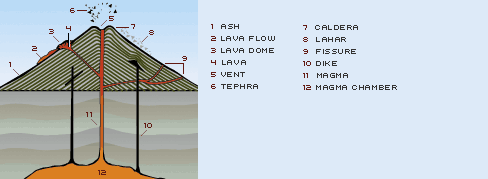|
Caldera
A caldera is a large, usually circular depression at the summit of a
volcano formed when
magma is withdrawn or
erupted from a shallow underground magma reservoir. The removal of
large volumes of magma may result in loss of structural support for
the overlying rock, thereby leading to collapse of the ground and
formation of a large depression. Calderas are different from
craters, which are smaller, circular depressions created primarily
by explosive excavation of rock during eruptions.
Left: Mount Aso vents a large cloud of steam at Japan's Aso
National Park. The mountain's caldera is one of the world's largest.
|



